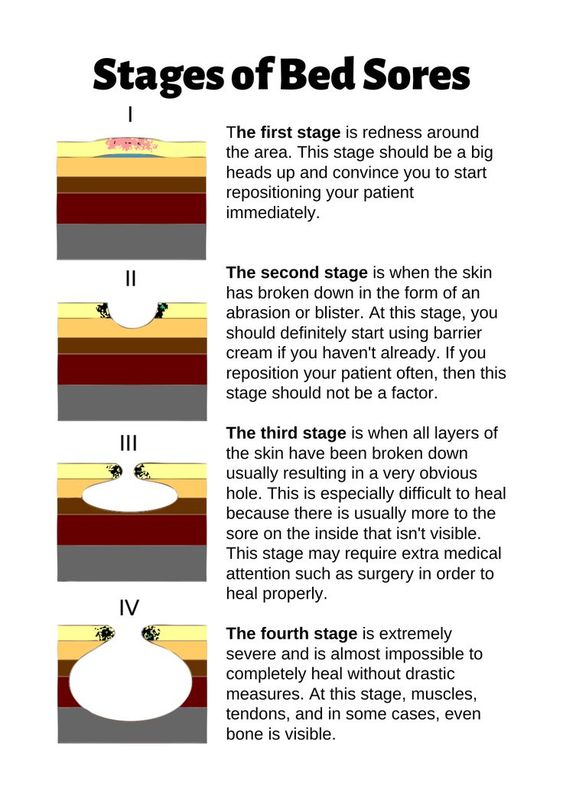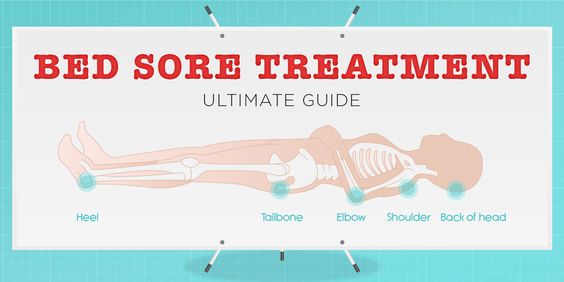Bed sores or pressure sores are injuries which develop when your skin faces prolonged pressure. This typically happens when a person is confined to a wheelchair or bed for long periods due to medical reasons. The sustained pressure on some areas on your body can then lead to reduced blood supply to the skin and tissue underneath and cause sores in the area.
Pressure ulcers or bed sores can develop on any part of your body that’s under pressure though they are typically found on bony areas such as your hips, elbows, the base of your spine, and your heels. The appearance of a bed sore can change depending on how severe it is.
Stage 1: Skin may feel warm and look red. If you have dark skin, the sore may have a purple or blue tinge. You may also experience pain, itching, or a burning sensation.
Stage 2: You may have an open sore which looks like a blister or cut, and surrounding skin may be discolored. You may also experience significant pain.
Stage 3: Bed sores at this stage tend to be deeper and may look like a crater. This points to greater damage to the tissue underneath the skin.
Stage 4: You see large wounds due to severe tissue and skin damage at this stage. Bones, tendons, muscles, and joints are likely to be visible at this stage. There is also an increased risk of infection.
1. Start With Preliminary Care: Relieve Pressure, Remove Dead Tissue, And Clean And Dress
Taking care of a bed sore involves the following broad steps:
- Relieve pressure from affected areas.
- Keep the sore clean, dress it, and change dressings as appropriate.
- Remove dead tissue which can hamper healing and even lead to infection.
- Have a healthy diet which can help with healing.
We’ve taken a look at some simple and natural ways of addressing these aspects below. But do keep in mind that severe or infected bed sores require medical attention. It also makes sense to clear any home treatment plan with your doctor beforehand.
Pull quote: See a doctor immediately if your skin becomes red and swollen, if you have pus coming out of your bed sore, or it smells bad. A fever with a temperature of 100.4°F (38°C ) or more, a rapid heartbeat, cold skin, and worsening or intense pain are other signs of an infection which needs medical attention.
2. Shift Positions Frequently
It is important to ease pressure on the affected area if you have a bed sore. For this, you need to change positions frequently. Typically, if you use a wheelchair, you should try to shift positions every 15 minutes. And if you are bedridden, your carer should move you every couple of hours.

3. Use Mattresses And Cushions Which Relieve Pressure
Special cushions, pillows, mattresses, and even booties are available which help ease pressure on the affected area. These may be filled with air or water to provide extra cushioning or support. Depending on your wound, your doctor can recommend the most suitable kind of foam or pressure-redistributing mattress or cushion for you. Positioning pillows strategically can help ease pressure on vulnerable areas. For instance:
- When you are lying down on your side, place pillows underneath so that your weight falls on your buttocks rather than the hip bone.
- Place pillows between your legs to keep ankles and knees apart.
- When you are lying down on your back, you can raise your ankles slightly up by placing a pillow beneath the lower calves.
4. Keep The Wound Clean With Soap And Water Or Saline
Maintaining good hygiene is important to prevent infection as the wound heals. In the initial stage, clean your wound with a gentle soap and water. A stage 2 wound can be cleaned by washing the area with a water and salt solution. The saltwater solution helps to get rid of dead, loose tissue as well excess fluid from the wound. Medical assistance is usually recommended for cleaning bed sores that are at stage 3 or 4.
5. Use Honey, Alginate, Or Hydrocolloid Dressings
Special dressings that can quicken healing can be used to treat bed sores. Some dressings that have been found to help include:
Honey dressing: Research indicates that using honey in the wound dressing can lead to improved wound healing and pain relief in people with bed sores. In one study, a honey and metronidazole dressing proved much more effective than a dressing with the antibiotic powder alone. Honey also has beneficial astringent and antimicrobial properties. Use medical grade honey readily available at drugstores for this purpose.
Hydrocolloid dressing: These biodegradable bandages are made of a special hydrated gel which molds to the bed sore and encourages skin growth and healing.
Alginate dressing: Devised out of seaweed, alginate dressings have calcium and sodium fibers which quicken healing.
Various other dressings such as films, foams, and antimicrobial dressings can also be used for bed sores. Gauze dressings are usually not considered ideal for bed sores. Talk to your doctor about the dressing most suitable for you. They will also be able to tell you how frequently your dressing needs to be changed since that also depends on the severity of the sore as well as the kind of dressing that you use.

6. Pack The Wound With Sugar
Sugar is an ancient remedy for tackling bed sores and wounds. Sprinkle granulated sugar on the sore or apply a paste of sugar before bandaging the wound. Sugar is thought to work by drawing in water and promoting the growth of new tissue. It dehydrates infection-causing bacteria as well. Also, sugar becomes slightly liquid-like as it absorbs fluid from your wound, so it’s easier to rinse it out along with all the dead tissue when you change your dressing.
7. Use Turmeric Paste
Turmeric is well known for its wound-healing properties in ayurveda. Applying a paste of turmeric powder and sterile water can help heal bed sores. Curcumin, a bioactive compound present in turmeric, quickens healing and enhances cellular proliferation. It also promotes the synthesis of collagen, which is a protein that provides strength and structure to your skin and connective tissues. This leads to better skin growth, tensile strength, and better wound contraction. Turmeric also acts against many infection-causing pathogens.
8. Apply A Neem Oil Ointment And Have Turmeric Milk
Ayurveda also values neem for its healing abilities. One study looked at the impact of applying neem oil and taking turmeric supplements on various chronic non-healing wounds, including bed sores. It was found that after 8 weeks, 50% wound healing took place in about 40% of the group with chronic wounds that used neem oil. But in another group given turmeric supplements alongside a topical application of neem oil, 70% of the subjects saw this degree of healing. Like turmeric, neem oil helps build collagen. It also helps maintain skin elasticity and keeps the wound moist, which can promote quicker healing. So try this winning combination to deal with bed sores.
Some experts advise against applying undiluted neem oil as it can be quite potent. So you might want to dilute it with a carrier oil or, better still, try an ointment with neem oil. For a healthy intake of turmeric, have turmeric tea or milk and include the spice in your daily cooking.
9. Use A Raw Papaya Paste To Remove Dead Tissue
The presence of dead tissue in a bed sore can have a detrimental effect on healing and even result in infection. So this needs to be removed periodically. From simple measures like rinsing a bed sore when you change the dressing to using special dressings which help dissolve dead tissue, there are many ways of clearing dead tissue. Surgical removal may be required in severe cases. Your doctor will advise you on the method best suited to you. One natural remedy worth exploring for this is papaya.
Raw papaya contains an enzyme called papain with exfoliating properties. Applying a paste of raw papaya can, therefore, effectively remove dead tissue.

10. Have A Healthy Diet With Enough Zinc, Vitamin C, And Protein
Having a healthy, balanced diet can help quicken the healing process. Some nutrients that have been found to be particularly helpful for wound healing include:
- Vitamin C helps in the synthesis of collagen. Citrus fruits and green leafy veggies are good sources of this important nutrient.
- Protein helps you grow healthy new tissue. Beans, nuts, dairy products, eggs, and meat can give you a good dose of protein.
- Zinc is a cofactor for many enzymes needed for cell proliferation and cell membrane repair and growth. You can get zinc from red meat, oysters, poultry, and sea food.
- It’s also important to get enough fluids as wound healing gets hampered when your skin gets dry.
